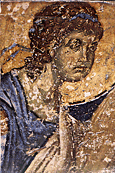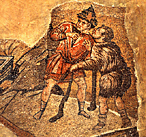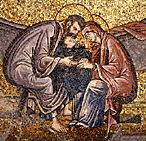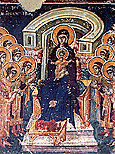 |
|
 |
14th century: Painting
 he return to older models
he return to older models
 and the emphasis laid on classicistic values in painting and generally in art are elements which characterise the Palaiologan era and which have led to the period being described as a renaissance. The monumental-plastic tendency, prevailing during the third quarter of the 13th century, reached its climax around 1300 and at the same time attained a point of exaggeration that would eventually lead to its decadence. Among the works that followed this new style, which appeared at the beginning of the 14th century and is known as the second Palaiologan style, are a large number of paintings of superlative quality. and the emphasis laid on classicistic values in painting and generally in art are elements which characterise the Palaiologan era and which have led to the period being described as a renaissance. The monumental-plastic tendency, prevailing during the third quarter of the 13th century, reached its climax around 1300 and at the same time attained a point of exaggeration that would eventually lead to its decadence. Among the works that followed this new style, which appeared at the beginning of the 14th century and is known as the second Palaiologan style, are a large number of paintings of superlative quality.
 Once again, the classical tradition became the source of inspiration for the new style, which is characterised by a greater elegance, by figures with fine, symmetrical proportions and by emotional intensity, but which at the same time seems more familiar and human. Once again, the classical tradition became the source of inspiration for the new style, which is characterised by a greater elegance, by figures with fine, symmetrical proportions and by emotional intensity, but which at the same time seems more familiar and human.
There are changes also in the iconography and in the choice of subjects that decorate the churches.
 Elements of genre painting, vignettes of everyday life, are introduced into the Christological scenes, giving them an air of reality. The architectural details, which create a rich and impressive setting, contribute to the same feeling. Scenes from the Passion of Christ,
his childhood and the life of the Virgin enrich the iconographic cycles. The Divine Liturgy is another source of inspiration for the artists, who translate into pictures Elements of genre painting, vignettes of everyday life, are introduced into the Christological scenes, giving them an air of reality. The architectural details, which create a rich and impressive setting, contribute to the same feeling. Scenes from the Passion of Christ,
his childhood and the life of the Virgin enrich the iconographic cycles. The Divine Liturgy is another source of inspiration for the artists, who translate into pictures
 the most important and best-known hymns such as the Christmas
Sticheron
and the
Akathistos hymn. the most important and best-known hymns such as the Christmas
Sticheron
and the
Akathistos hymn.
After
the middle of the century the dominant aesthetic tendency will evolve into a current of refined mannerism, which in certain monuments will assume a lyrical and intensely decorative mood. At the same time, a new creative spirit will make its appearance in works of the end of the century, to which the intense chromatic contrasts, the dynamic expression and fleeting brushstrokes give an almost expressionistic tone.
|